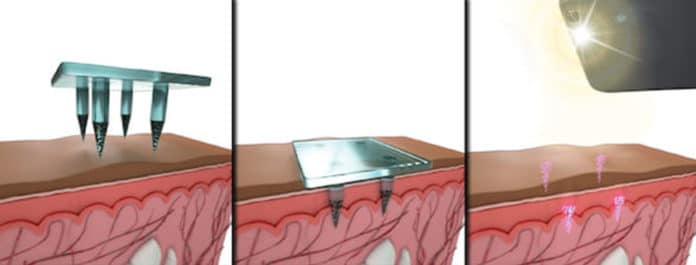Accurate medical recordkeeping is a significant challenge in many low-resource settings where well-maintained centralized databases do not exist, contributing to 1.5 million vaccine-preventable deaths annually. Now, a new Rice University professor Kevin McHugh, along with his colleagues, has invented a technology for more standardized immunization recordkeeping.
The technology, as suggested, can keep track of the child’s shots. Scientists, in real, have developed quantum-dot tags that encode medical history on a patient. These near-infrared tags are invisible to the naked eye yet detectable when exposed to NIR light.
The tags are incorporated in only some of the array of sugar-based microneedles on a patch. When the needles dissolve in about two minutes, they deliver the vaccine and leave the pattern of tags just under the skin, where they become something like a bar-code tattoo.
Moreover, instead of ink, this highly specific medical record consists of copper-based quantum dots embedded in biocompatible, micron-scale capsules. Their near-infrared dye is invisible, but the pattern they set can be read and interpreted by a customized smartphone.
The tag holds up to 16 tiny 1.5-millimeter needles that don’t go very deep, which makes them theoretically painless and a lot easier for kids. As they disintegrate in the skin, no biohazardous sharps remain for disposal.
McHugh said, “The Bill and Melinda Gates Foundation came to us and said, ‘Hey, we have a real problem — knowing who’s vaccinated. We go on vaccination campaigns where people get into Hummers, drive to a rural village, set up a tent and start immunizing people, but they don’t always know who’s been immunized before and what vaccines are still needed.'”
McHugh said, “Parents often don’t know their children’s vaccination histories. So our idea was to put the record on the person. This way, later on, people can scan over the area to see what vaccines have been administered and give only the ones still needed.”
“There are two sides to this. First, is that you don’t administer unnecessary vaccines, which has a cost. But even bigger, you don’t leave people under-immunized and at risk of getting an infectious disease.”
McHugh is planning to continue the work as several aspects of this work need to work on, including, nanotechnologists, bacteriologists, chemists, and computer scientists.
The study is published in Science Translational Medicine.
